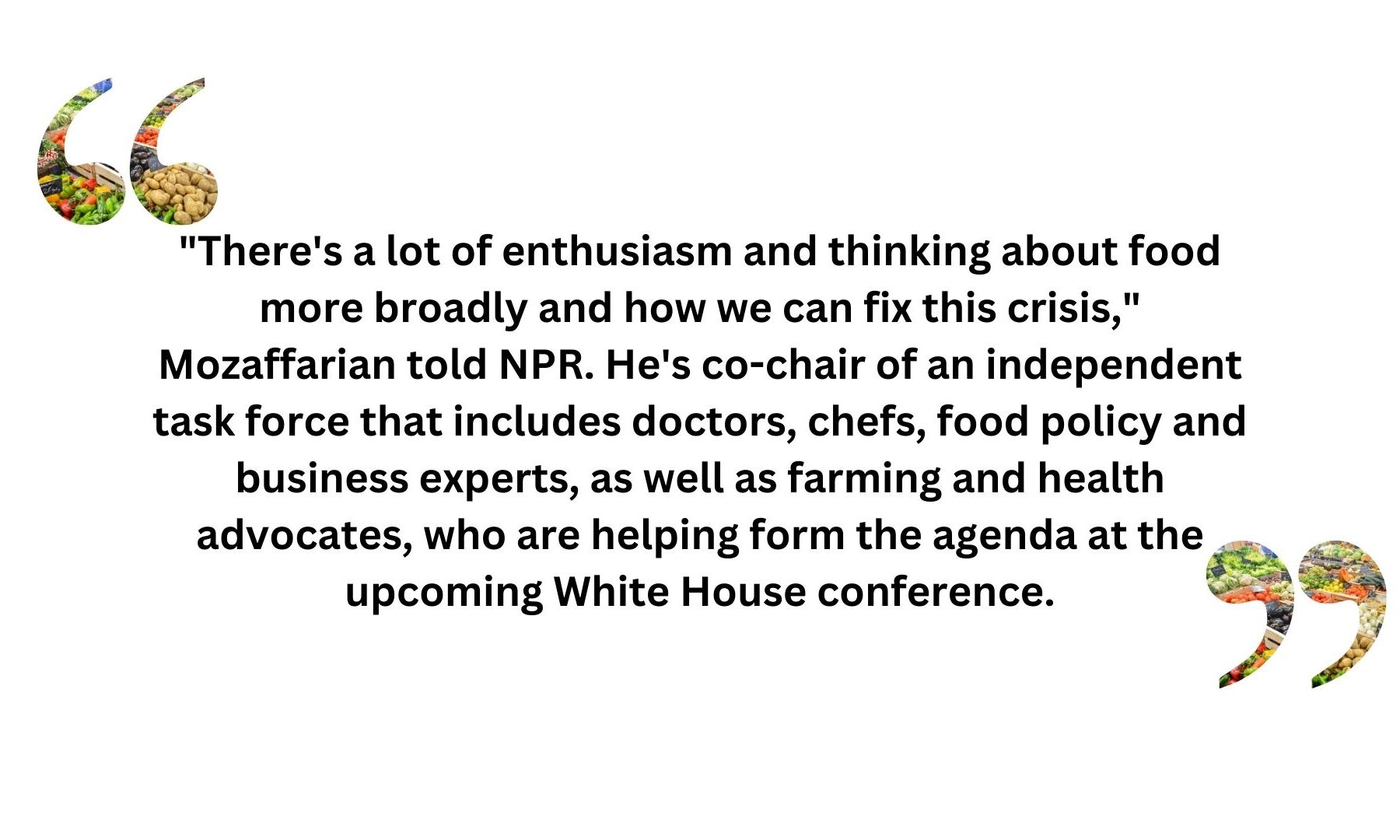Shaping A National Nutrition Narrative: Generating Media Around the White House Conference on Hunger, Nutrition, and Health
The Gerald J. and Dorothy R. Friedman School of Nutrition Science and Policy at Tufts University

Background
Lack of good nutrition is a leading cause of illness and death in the U.S. This crisis is also deeply inequitable — too often, people with lower incomes, those living in rural communities, and people from historically marginalized racial and ethnic groups face systemic barriers to the healthy foods they need to thrive.
Thankfully, in 2022 the Biden-Harris Administration announced it would host a White House Conference on Hunger, Nutrition, and Health. Set to be the first gathering of its kind in more than 50 years, the Conference would bring together bipartisan federal policymakers, anti-hunger and nutrition advocates; academics; food companies; the health care community; local, state, territorial and Tribal governments; and people with lived experiences. Attendees would work together to advance solutions to reducing diet-related disease, ending hunger, and improving nutrition across the U.S.
The Client
In the lead up to the Conference, Tufts University Friedman School of Nutrition Science and Policy and its then Dean for Policy, Dr. Dariush Mozaffarian, wanted to center nutrition security and Food is Medicine solutions in the national dialogue and the minds of key policymakers to help ensure meaningful action steps in these areas emerged from the Conference. Dr. Mozaffarian partnered with allies Chef José Andrés, former U.S. Ambassador to the United Nations Agencies for Food and Agriculture Ertharin Cousin, former Majority Leader of the U.S. Senate Bill Frist (R-TN), and former U.S. Secretary of Agriculture Dan Glickman to form the Task Force on Hunger, Nutrition, and Health. In August of 2022, the Task Force laid out their top identified priorities, releasing a corresponding report: Informing the White House Conference: Ambitious, Actionable Recommendations to End Hunger, Advance Nutrition, and Improve Health in the United States. This group, with the shared goal of turning these priorities into federal actions, turned to Waxman to lead communications for their combined efforts.
The Results
Through a strategically crafted plan of drumbeat communications, reporter relationship-building, deliberate and timely outreach, and strong narrative construction, Waxman Strategies garnered significant media attention — in turn, centering the Task Force’s policy recommendations nationally and inside the Beltway, and positioning Dr. Mozaffarian and the Task Force collectively as the thought leaders leading up to the Conference.
By elevating the Task Force and their proposed solutions to the inequitable health issues plaguing our nation ahead of the Conference, Waxman changed the way large media outlets talked about the historic event itself. In doing so, we ultimately helped our client influence key policymakers’ perception of this health crisis, the better future that is possible, and actions we can take to get there.
Approximately one month before the Conference took place, Dr. Mozafarrian and the Task Force were featured in NPR’s piece, The U.S. diet is deadly. Here are 7 ideas to get Americans eating healthier. NPR detailed the monumental role the Task Force was playing in the national movement towards building nutrition and food equity, and laid out seven of the Task Force’s recommendations to advance nutrition and health.

This success in shaping the national narrative can also be seen in measurable outcomes: Waxman Strategies’ tactical media relations generated positive coverage of the Task Force in over 25 media placements in both national and beltway-focused outlets — to include NPR, STAT News, Politico, the Wall Street Journal, and more — with a total estimated reach of over 268 million.
The Road to Results – How We Did It
To achieve the results above, Waxman Strategies worked with the Task Force across the months leading up to the Conference to do drumbeat communications that would steadily build a public profile for the new Task Force and, importantly, forge the strong relationships with key reporters; we knew this would allow us to center our client in the narrative at the moment that mattered most. Waxman led the charge by translating the dense science and wonky policy background of the Task Force’s priorities, underlining how these priorities could forcecast the seismic federal actions to come.
The Steady Drumbeat: Key to this work was using every possible peak — such as stakeholder events the Task Force was assembling across the country or announcements from key policymakers on issues related to the Conference — to spotlight the Task Force, its report, and its perspective. To do so, Waxman conducted a well-coordinated orchestra for every release and statement — from drafting the text and managing collaboration and approval across Task Force groups, to leading pitching and reporter relations in media markets across the country.
The Crescendo Moment for Impact: The Waxman team knew the week of the historic Conference was our key moment to center our client’s agenda. When the week arrived, our months of drumbeat pitching and relationship building yielded their full results. As their deadlines for pieces forecasting the Conference approached, reporters looked to us for the content they needed. Between having easily digestible data on hand, time reserved for interviews with Task Force members, and our partnership with our client’s team and the staff of other Task Force members well-oiled — we were ready for them.
The results are clear. In combination with the Task Force’s deep commitment to fighting nutrition insecurity and advancing Food is Medicine programs, our strategic communications significantly molded the national nutrition narrative surrounding the Conference, shaping the background against which important stakeholders and policymakers spoke and thought about hunger and nutrition policy during a key moment of American history.
